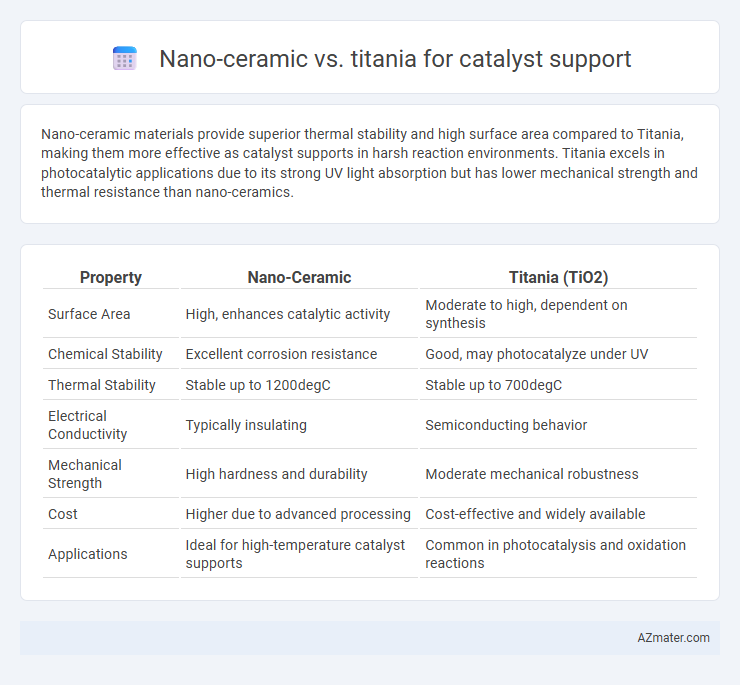Nano-ceramic materials provide superior thermal stability and high surface area compared to Titania, making them more effective as catalyst supports in harsh reaction environments. Titania excels in photocatalytic applications due to its strong UV light absorption but has lower mechanical strength and thermal resistance than nano-ceramics.
Table of Comparison
| Property | Nano-Ceramic | Titania (TiO2) |
|---|---|---|
| Surface Area | High, enhances catalytic activity | Moderate to high, dependent on synthesis |
| Chemical Stability | Excellent corrosion resistance | Good, may photocatalyze under UV |
| Thermal Stability | Stable up to 1200degC | Stable up to 700degC |
| Electrical Conductivity | Typically insulating | Semiconducting behavior |
| Mechanical Strength | High hardness and durability | Moderate mechanical robustness |
| Cost | Higher due to advanced processing | Cost-effective and widely available |
| Applications | Ideal for high-temperature catalyst supports | Common in photocatalysis and oxidation reactions |
Introduction to Catalyst Supports
Nano-ceramic and titania serve as critical catalyst supports due to their unique structural and chemical properties that enhance catalyst performance. Nano-ceramics offer high thermal stability and surface area, which promote better dispersion of active catalytic sites and increased reaction efficiency. Titania, known for its strong metal-support interactions and photochemical activity, improves catalyst durability and facilitates electron transfer during catalytic processes.
Overview of Nano-Ceramic Materials
Nano-ceramic materials exhibit exceptional thermal stability, high surface area, and strong mechanical strength, making them ideal catalyst supports in chemical reactions. Their nano-scale pores enhance reactant adsorption and facilitate efficient electron transfer, which improves catalytic activity compared to conventional supports. Common nano-ceramics such as alumina, zirconia, and silica provide tailored surface chemistry and durability, outperforming titania in harsh reaction environments.
Properties of Titania as a Catalyst Support
Titania exhibits exceptional thermal stability and strong metal-support interaction, crucial for catalyst performance and durability. Its unique acid-base properties and high surface area enhance the dispersion of active metal sites, improving catalytic efficiency. Additionally, titania's photocatalytic activity enables advanced oxidation processes, making it a versatile catalyst support in environmental and energy applications.
Comparative Structure and Morphology
Nano-ceramic catalyst supports exhibit a highly porous structure with a large surface area, promoting enhanced dispersion of active metal particles. Titania (TiO2) offers a well-defined crystalline morphology, typically anatase or rutile phases, contributing to strong metal-support interactions and improved thermal stability. While nano-ceramics provide superior surface tunability and mechanical strength, titania's unique electronic properties enhance catalytic activity through charge transfer processes.
Surface Area and Porosity Differences
Nano-ceramic catalyst supports exhibit higher surface area and enhanced porosity compared to Titania, facilitating greater active site dispersion and increased catalytic efficiency. Titania supports typically possess lower surface area with more uniform but smaller pore sizes, limiting mass transfer and active site accessibility in some catalytic processes. The superior porosity and surface characteristics of nano-ceramics often result in improved reactant diffusion and catalyst stability under harsh reaction conditions.
Thermal Stability and Durability
Nano-ceramic materials exhibit superior thermal stability compared to titania, maintaining structural integrity at temperatures exceeding 1000degC, which is crucial for catalyst support in high-temperature reactions. Titania, while effective in low to moderate temperature applications, tends to undergo phase transformations that reduce its durability and surface area over prolonged thermal exposure. The enhanced durability of nano-ceramic supports results in significantly prolonged catalyst lifespan and consistent catalytic performance under harsh thermal conditions.
Chemical Compatibility with Catalysts
Nano-ceramic materials exhibit superior chemical compatibility with a wide range of catalysts due to their high thermal stability and resistance to acidic or basic environments. Titania (TiO2) also maintains good chemical stability but can interact with certain catalyst components, potentially affecting catalytic activity through support-induced electronic effects. Selecting nano-ceramic supports often enhances catalyst longevity and performance in harsh chemical conditions compared to titania-based supports.
Catalytic Performance: Nano-Ceramic vs Titania
Nano-ceramic supports exhibit superior catalytic performance due to their enhanced thermal stability, higher surface area, and greater resistance to sintering compared to titania supports. Titania often suffers from phase transformation and reduced active site dispersion at elevated temperatures, limiting its long-term catalytic efficiency. Nano-ceramics enable stronger metal-support interactions, resulting in improved catalyst activity, selectivity, and durability in harsh reaction conditions.
Industrial Applications and Use Cases
Nano-ceramic materials offer superior thermal stability and resistance to chemical corrosion, making them ideal catalyst supports in high-temperature industrial processes such as petroleum refining and chemical synthesis. Titania (TiO2), valued for its excellent photocatalytic properties and high surface area, is widely used in environmental applications like wastewater treatment and air purification. Industrial use of nano-ceramics typically emphasizes durability under harsh conditions, while titania catalysts excel in reactions driven by light exposure and oxidative processes.
Future Trends in Catalyst Support Materials
Nano-ceramic materials demonstrate superior thermal stability and high surface area, making them ideal for future catalyst support applications in harsh reaction environments. Titania offers excellent photocatalytic properties and strong metal-support interactions, driving advances in energy-efficient and environmental catalysis. Emerging trends focus on hybrid nano-ceramic/titania composites to optimize mechanical strength, catalytic activity, and durability under diverse industrial conditions.

Infographic: Nano-ceramic vs Titania for Catalyst support
 azmater.com
azmater.com